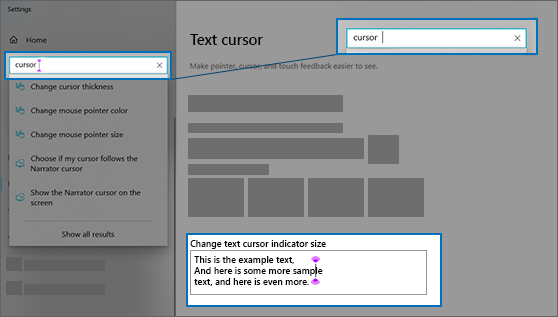There are lots of ways to make the devices that you use to interact with your PC—like a mouse or keyboard—easier to use.
Make the mouse easier to use #
To access mouse settings, select the Start button, then select Settings > Ease of Access > Mouse .
- Turn on the toggle under Control your mouse with a keypad if you want to control your mouse using a numeric keypad.
- Select Change other mouse options to change your primary mouse button, set scrolling options, and more.
- If you want your pointer to display a trail across the screen when you move it, select Additional mouse options, and check the box next to Display pointer trails on the Pointer Options tab.
Make your mouse pointer easier to see #
Make your mouse pointer easier to see by making it bigger or changing the color.
- Select Start > Settings > Ease of Access > Mouse pointer .
- Adjust the slider under Change pointer size until your mouse pointer is the size you’d like.
- Change the color of your mouse pointer to white, black, inverted, or any of the bright suggested colors. To choose any color from a color wheel, select Pick a customer pointer color.
Make your text cursor easier to see #
Windows 10 lets you change the thickness of the text cursor and add a colorful indicator to make it more visible.
Change the text cursor thickness #
- Select Start > Settings > Ease of Access > Text cursor.
- Adjust the Change text cursor thickness slider until it looks like you want in the preview.
Use the text cursor indicator #
- Select Start > Settings > Ease of Access > Text cursor.
- Select Turn on text cursor indicator.
- Adjust the Change text cursor indicator size slider until it looks like you want in the preview.
- Select one of the Suggested text cursor indicator colors, or select Pick a custom color to choose your own.

Make the keyboard easier to use #
If you want to make your keyboard easier to use, select Keyboard settings below, or select the Start button, then select Settings > Ease of Access > Keyboard , and try some of these options:
- Turn on the toggle under Use the On-Screen Keyboard to select keys by using the mouse or another pointing device (like a joystick) or to use a single switch to cycle through the keys on the screen.
- Turn on the toggle under Sticky Keys if you have trouble pressing two keys at the same time. Sticky Keys let you press commands that use multiple keys (such as Ctrl + S) one key at a time.
- Turn on the toggle under Toggle Keys to play a sound whenever you press the Caps lock, Num lock, or Scroll lock keys.
- Turn on the toggle under Filter Keys to set the sensitivity of the keyboard so it can ignore brief or repeated keystrokes.
- Turn on the toggle under Change how keyboard shortcuts work to underline access keys when they’re available.
- Turn on the toggle under Print Screen shortcut to use the Prt Scr button to open screen snipping.Tip: You can also control your PC with just your voice by using Windows Speech Recognition. To learn more, see Use voice recognition in Windows.
